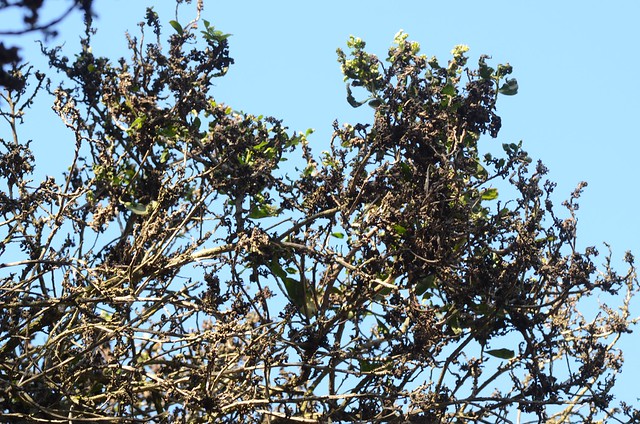RECENT ARTICLES
- CEBRA: An optimised and standardised sampling protocol for BioBlitz
- Stop it people, the plural of anecdote IS data!
- That's no pollinator, that's a flower visitor
- Add a scale to your macro photos
- What to photograph when counting the wild
- Imagine counting the wild on EVERY street in a city!
- My wild counting workflow
- A butterfly flew through
- Why iNaturalist observations without photos can be research grade
- Why you shouldn’t use a spreadsheet for data entry
- All articles ...
The rise and fall of the New Zealand native tree, ngaio, in California
Here are my counts of wild New Zealand ngaio in Southern California, before and after one species of Australian thrips arrived and killed off most trees.
written Nov 12, 2013 • by Jon Sullivan • Category: Count Cache

I recently tried out DataDryad, “a nonprofit repository for data underlying the international scientific and medical literature.” It’s a great thing. You can now go there to find all the datasets I used for my recent Biological Invasions paper about New Zealand nagio (Myoporum laetum) in California and its die off caused by the invasion of a previously unknown species of Tasmanian thrips, now described as Klambothrips myopori.
All the data from this paper can be downloaded from DataDryad here. Here’s the title and abstract of the paper.
Inadvertent biological control: an Australian thrips killing an invasive New Zealand tree in California
Transport hubs of international trade and tourism are sites of unprecedented long-distance dispersal of species and novel ecological interactions. In cases of invasive plants released from their specialist natural enemies, novel interactions with both resident enemies and new arrivals can accumulate and potentially reduce weed competitiveness. I present here one dramatic example of this, where an invasive woody weed in southern California is being rapidly controlled by an accidentally introduced genus-specialist herbivorous insect. The New Zealand native shrub/small tree, Myoporum laetum, is a long- time popular ornamental plant in California and has become an invasive woody weed. In 2005, a Myoporum-specific thrips, Klambothrips myopori, was discovered (and described) in California feeding on M. laetum leaves. Several searches have failed to find K. myopori in New Zealand and a population has recently been discovered in Tasmania, Australia, feeding on Myoporum insulare. In 5 years, K. myopori has killed off about half of southern Californian M. laetum with almost all surviving individuals being gradually defoliated. Inadequate border biosecurity has resulted in inadvertent biological control, in a rapid timeframe, caused by a novel enemy. Unfortunately, K. myopori has subsequently been accidentally transported from California to Hawaii where it is now killing off Hawaiian native Myoporum sandwicense. Transport hubs can both connect weeds with natural enemies and disperse those enemies more widely.
NZ botanist Phil Garnock-Jones wrote a nice article on my paper over on his Theobrominated blog.
Update: NZ botanist Bec Stanley mentioned this study on Radio New Zealand National on Thursday night. You can listen here.
